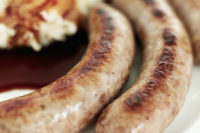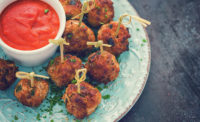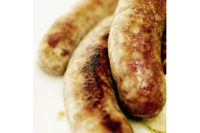Cover Story
The 2019 Sausage Report: Improving image as health & wellness gains momentum
As more processors offer selections with 'better-for-you' attributes, consumer perceptions of sausage as an unhealthy meal choice fades.












The sausage sector’s future is looking brighter.
While sausage maintains a strong shopper following despite concerns by many consumers that it is less healthy than other protein options, the sector is set to become more popular as merchandisers offer more selections with attractive attributes.
In an effort to lure the growing legion of wellness-oriented shoppers, retailers are marketing additional products that carry a wider scope of health claims, ranging from natural and organic to being developed without antibiotics and growth hormones.
Along with adding wellness elements to sausages, merchandisers are bolstering their conventional and premium offerings by rolling out selections with unique flavors.
Coleman Natural Foods, a Westminster, Colo.-based supplier of natural and organic meat and poultry, for instance, recently began marketing sausages as well as St. Louis-style smoked ribs and pulled pork that are formulated to feature the taste of Budweiser lager beer. The two bratwurst products — traditional beer bratwurst and spicy Jalapeno cheddar — feature the Budweiser brand and contain pork from animals raised without antibiotics.
“Sausage is one of the most innovative meat categories, with newer selections incorporating different types of proteins, ingredients, spices and flavors, and sellers are using more merchandising techniques to market the items,” says Anne-Marie Roerink, principal of 210 Analytics, a San Antonio-based market research and marketing strategies firm.
She says there is a greater array of chicken and turkey sausages in both the frozen food aisle and meat and deli departments of supermarkets, with meat blends and plant-based sausages also becoming more prevalent. There also are additional SKUs of more traditional pork and beef sausages, including more sweet and savory selections and ethnic and American flavors, she says.
“It is this range of innovation that prompts trial in the meat department,” Roerink says, “which is very important given shoppers’ tendencies to purchase the same items again and again.”
Marketing wider varieties of sausages, and especially items with healthier attributes, will generate greater interest from the large base of Millennial shoppers, she says.
“Much like burgers, sausage and brats are easy to prepare so it is a good segment for innovation with younger shoppers, particularly as younger generations continue to focus on protein intake but do not always turn to meat to do so,” she says.
Further merchandising activity will likely include the launch of more breakfast sandwiches that feature sausage, Roerink says, noting egg and sausage combos already are popular and newer additions capitalize on consumer interest in convenient items.
The strong shopper focus on wellness, meanwhile, is making lower-fat turkey, chicken and plant-based sausages, which have powerful health halos, increasingly popular. Demand also is increasing for products with such claims as no artificial colors and flavors, less sugar, low fat, antibiotic free and no high fructose corn syrup, she says.
“Decisions surrounding eating healthier often simply constitute feeling a little better about something shoppers bought today versus what they bought before,” Roerink says. “It is important to keep in mind that health strategies are extremely personal, so having a range of options is often the best way to win with all shoppers.”
Cost is a concern
While the greater availability of “better for you” products will add to sausage’s appeal, sausage marketers already benefit from merchandising selections that typically are lower in price than fresh whole cuts of meat, says Anna Amir, an analyst with IBISWorld, a Los Angeles-based market research firm.
“When meat prices rise across the board, budgeting consumers switch from pricier meats to hot dogs and sausages,” Amir says in IBISWorld’s December 2018 Hot Dog and Sausage Production in the U.S. report.
“Conversely, when meat prices decline, consumers do not abandon hot dogs and sausages for steaks and burgers,” she says. “Therefore, industry products still maintain a solid consumer base. This dual appeal, both in terms of pricing value and product preference, helps keep the industry from becoming overly volatile and enables profit margins to remain fairly stable.”
Though the majority of sausage selections still consist of pork and beef, Amir says chicken and turkey products will play a more significant merchandising role.
“Health factors will continue to be a concern, and operators will adapt to consumer preferences by developing new, more healthful options,” she says. “Products traditionally made with red meat will be reinvented with poultry meat, a much leaner meat option. Companies also will make other product adjustments, including decreasing sodium content or using organic meat to appeal to changing consumer health preferences.”
While wellness attributes are significant purchase drivers, cost will continue to be the most important sausage attraction, Amir says, stating that as the price of other meat products increases, consumers will purchase more sausage and other substitute sources of protein.
Worries about the use of antibiotics and chemicals in sausage production, meanwhile, are causing a segment of shoppers to shift to organic and nontraditional options, she says.
“The nutritional and ethical qualities of meat have become increasingly important,” Amir says. “Consumers are more concerned about what they are eating and how it gets to their dinner plates. The perception of red meats as unhealthy has led more people to choose white meats as a protein source. Producers of red meat have responded with reduced fat contents and leaner sausage options.”
Prepare for closer shopper scrutiny
Greater consumer interest in natural foods also is resulting in changing sausage ingredient statements, says Eric Mittenthal, president of the Washington, D.C.-based National Hot Dog and Sausage Council.
“We see more products using natural sources of nitrite, such as celery powder, and containing as few ingredients as possible,” he says.
Merchandisers also will benefit by being transparent about the ingredients in sausage and detailing why the elements are present and where they originate, Mittenthal says, adding that it is important to “highlight the nutrition benefits of prepared products like sausages and debunk many of the common myths that remain, particularly those that are nutrition related.”
Marketers can help diminish concerns about the health aspects of sausages, Mittenthal says, by emphasizing the availability of naturally cured products and the large amount of selections with lower sodium and fat.
The wellness attributes of chicken sausages, meanwhile, are becoming more pronounced as newer varieties incorporate vegetables and fruit, including spinach, kale, sun-dried tomatoes and apples, while Swiss chard, beets, citrus and mushrooms are in the pipeline, says Tom Super, senior vice president of the Washington, D.C.-based National Chicken Council (NCC).
To support a wider range of eating occasions, he says more sausage merchandisers will market products that are attractive for snacking and parties, such as those with interesting tastes.
“Offering these products in more convenient forms, such as chunks and slices, should up the appeal, especially for time-challenged consumers,” Super says.
Traditional pork sausage manufacturers, as well as newer and smaller operators, also will likely offer more sausage blends, such as pork with chicken, “following the lead of the pork and poultry hot dogs which have been popular for decades,” he says. “Such combinations will provide consumers with value and also potentially better nutrition and taste.”
In addition, sausages that provide better grilling experiences are becoming increasingly prevalent, Super says.
“More robust flavors and juicier ingredients that stand up better to intense temperatures will be important components of the grill-oriented products,” he says.
A pathway to added activity
Merchandisers who respond to evolving shopper attitudes will be in position to boost sausage sales.
The rollout of more sausages selections with “better for you” and other product claims could be the triggers that invigorate a relatively sluggish market.
While dollar and unit sales for refrigerated dinner sausage were up 3 percent and 2.6 percent, respectively, for the 52 weeks ending April 21, refrigerated breakfast sausage/ham sales grew just 1.7 percent and 0.5 percent, respectively, and frozen-sausage sales were only up 1.3 percent and 0.5 percent, according to Information Resources Inc. (IRI), a Chicago-based market research firm.
“Some retailers are slow to target the growing number of consumers who are looking for pork or meat products that are raised without the use of antibiotics, or in the case of pork, growth promoters,” says Mel Coleman, vice president of Coleman Natural Foods, a Westminster, Colo.-based supplier of natural and organic meat and poultry, including sausages. “But consumers’ needs are constantly changing. They do a lot of value-based buying and if one of their strong values, for instance, is about animal welfare and how animals are treated, they will pay more money for brands that address those values.”
Shoppers who avoid sausages and hot dogs point to health issues as the most important reason for avoiding the category, according to Mintel Group Ltd., a Chicago-based global market research firm, in its October 2017 Hot Dogs and Sausages U.S. report.
“Even consumers that participate in the category express negative attitudes about the safety and health of hot dogs and sausages,” the report shows. “Nearly a third of purchasers are worried about meat quality and a quarter say they are unhealthy.”
Wellness wallop
Thirty-six percent of respondents in a Mintel online survey indicated they don’t purchase hot dogs or sausages because the items are too processed. Other reasons cited for not buying the items are that they are unhealthy (28 percent); have too much sodium (27 percent); have too much fat (23 percent); and have too many calories (13 percent).
The nationally representative survey featured 548 internet users ages 18 and older who had not purchased any packaged sausage or hot dog in the previous six months.
“Products positioned as premium and with ingredients and claims that hint at healthiness may be an ideal combination that activates some nonusers and keeps consumers engaged and perhaps even more so in the category,” Mintel reports.
Merchandisers can enhance the perception that a brand is better for you and/or premium by spotlighting the absence of “demonized” ingredients, such as nitrates and nitrites, and launching items made with poultry as nearly a quarter of sausage and hot dog buyers agree that poultry options are better for you than red meat selections, Mintel reports.
“While health issues still loom, the stigma of these processed meats may be tempered by communicating an element of premium through free from claims, ingredient integrity and flavor while remaining true to the core strengths of the products,” the report shows.
— Richard Mitchell
Accelerate activity with product promotions
While a steady stream of new sausage options is making the category more attractive, it also adds merchandising challenges for processors and retailers, says Dana Ehrlich, chief executive officer, co-founder and owner of Verde Farms, a Woburn, Mass.-based beef sausage supplier.
“It can be a crowded category where there are a lot of items on the shelves,” he says. “Assortments often overlap, so retailers need to understand the interests of their consumers, who might not have the same purchasing preferences as the store buyer.”
Verde Farms recently launched three varieties of Verde-branded health-oriented dinner sausages: Hatch Chile and Cheddar, Hardwood Smoked, and Chorizo Style and Queso Fresco, which are made with 100 percent grass fed and free-range beef, developed without antibiotics or added growth hormones and have no added nitrates or nitrites.
Ehrlich says sales are strongest when stores merchandise the items next to other beef products, rather than solely in a sausage area, as the shopper for grass-fed, natural and organic products is typically not going to visit the sausage section to seek items with wellness-oriented claims.
“Many consumers are going to assume that sausage section products are conventional and do not include the premium selections they are looking for,” he says. “Many shoppers won’t even walk 20 feet to take a look at the items. Premium sausages should be segregated from the conventional selections within the meat department, as well as from the natural and organic section in stores.”
Retailers can further spur shopper interest in premium sausages through in-store samplings and packaging that details the products’ clean ingredients and unique attributes, Ehrlich adds.
Other effective merchandising vehicles are limited-time offers “to keep flavor innovation frequent and constant,” Roerink says, and the positioning of breakfast sausage as a dinner option to expand the usage occasion. She adds that made-to-order sausage stations also are appearing in retail outlets.
“But one of the most powerful ways to prompt trial and purchase continues to be sales promotions,” Roerink says. “Given the routine nature of meat purchases, alerting shoppers to unique flavors and line extensions of traditional sausage flavors can be successful; however, it is important that promotions are focused on incremental sales versus substitution.
Make sausage a competitive standout
It also is beneficial for retailers to have sausage options that are not available in competing outlets — which can include brands, flavors and proteins — so shoppers equate innovation with the retailer, Roerink says. She adds, however, that SKU and space limitations can make it difficult to increase assortments, which is “where limited-time offers can provide some relief.”
Other marketing techniques that can boost sausage activity include in-store signage emphasizing sausage is a quick and easy breakfast or dinnertime option and cross-merchandising displays to spotlight sausage-based meal solutions, says Tara Dugan, director of consumer and marketplace insights for the Des Moines-based National Pork Board (NPB).
Retailers can emphasize sausage’s role as a tasty ingredient by including it with pasta or other complementary items from different store sections, or as a center-of-the-plate option by also featuring side dishes, she says.
National Pork Board research found highlighting meal solutions “will go a long way” in generating shopper interest in sausage and its accompaniments, Dugan says. Additional NPB research reveals that such claims as “premium,” “all-natural” and “fresh” are increasingly popular dinner sausage elements, while “sweet” and “hot” are favorable breakfast sausage attributes.
Dugan encourages retailers to position breakfast sausage as both a morning and evening meal, noting “many consumers are craving breakfast for dinner, and those who love the flavor and taste of both breakfast and dinner sausage will often be willing to consume the products in spite of health issues.”
Indeed, growth opportunities exist for products that convey versatility and convenience for small and large occasions, as well as for those items that connect to the emotional and social aspect of eating hot dogs and sausages, according to Mintel Group Ltd., a Chicago-based market research firm, in its October 2017 Hot Dogs and Sausages U.S. report.
Because greater than 50 percent of consumers buy more than one type of sausage or hot dog, merchandisers have the potential to expand product eating occasions, types or uses by having consumers perceive the items as being part of a meal or snack, or for use as an ingredient, Mintel says.
Marketers also are in position to enhance product revenues as more than a quarter of consumers agree that premium offerings are worth paying more for, and innovations in unique and bold flavors will likely appeal to the 28 percent of consumers who like to try new flavors, Mintel reports.
“Product development focused on elevated offerings featuring premium meats, ingredients or flavored varieties may help consumers who are looking for diversity as well as brands looking to cast a wider net of occasions,” Mintel says. NP
Looking for a reprint of this article?
From high-res PDFs to custom plaques, order your copy today!













